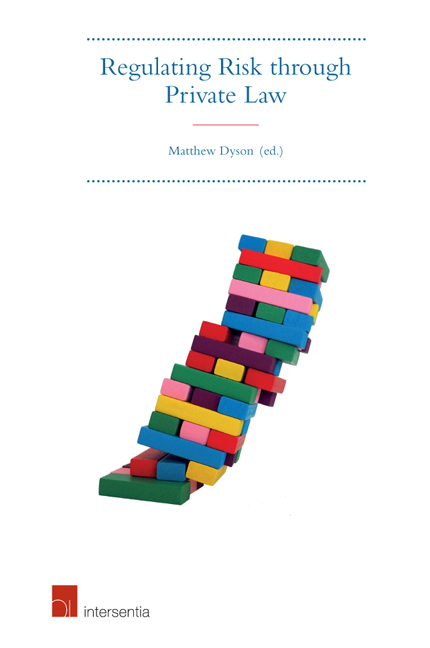Book contents
- Frontmatter
- Preface
- Contents
- Table of Cases
- List of Contributors
- Chapter 1 Introduction
- Part I Risk Overviews
- Part II State of the national art on risk
- Chapter 11 Legal Risk in International Commercial Disputes
- Chapter 12 Medical Accidents and Pharmaceutical Product Liability in France
- Chapter 13 Bearing and Sharing Risk in the Swedish Welfare State
- Chapter 14 Modernisation and Risk Regulation in the Italian Food Sector
- Chapter 15 Motor Vehicle Accidents Caused by Game Wandering onto Spanish Roads
- Chapter 16 Dutch Tort Law at the Crossroads: Judicial Regulation of Health and Environmental Risks
- Chapter 17 Sub Terra: Risk in the Chilean Mining Industry
- Chapter 18 Constitutionalising Rights and Reacting to Risk in South Africa
- Chapter 19 Regulating Risk in Brazil: Resort to General Clauses
- Chapter 20 What does Risk-Reasoning do in Tort Law?
- Chapter 21 Epilogue: What does Risk-Reasoning Tell Us about Tort Law?
- Index
- About the Editor
Chapter 16 - Dutch Tort Law at the Crossroads: Judicial Regulation of Health and Environmental Risks
from Part II - State of the national art on risk
Published online by Cambridge University Press: 13 October 2018
- Frontmatter
- Preface
- Contents
- Table of Cases
- List of Contributors
- Chapter 1 Introduction
- Part I Risk Overviews
- Part II State of the national art on risk
- Chapter 11 Legal Risk in International Commercial Disputes
- Chapter 12 Medical Accidents and Pharmaceutical Product Liability in France
- Chapter 13 Bearing and Sharing Risk in the Swedish Welfare State
- Chapter 14 Modernisation and Risk Regulation in the Italian Food Sector
- Chapter 15 Motor Vehicle Accidents Caused by Game Wandering onto Spanish Roads
- Chapter 16 Dutch Tort Law at the Crossroads: Judicial Regulation of Health and Environmental Risks
- Chapter 17 Sub Terra: Risk in the Chilean Mining Industry
- Chapter 18 Constitutionalising Rights and Reacting to Risk in South Africa
- Chapter 19 Regulating Risk in Brazil: Resort to General Clauses
- Chapter 20 What does Risk-Reasoning do in Tort Law?
- Chapter 21 Epilogue: What does Risk-Reasoning Tell Us about Tort Law?
- Index
- About the Editor
Summary
INTRODUCTION
JUDICIAL RISK REGULATION
It is the government’ s responsibility to protect its citizens against health and environmental risks. Governments have to enact regulations that set out the legal responsibilities of the relevant private actors – such as producers, developers of a technology, employers – with respect to risks. Moreover, these rules should ideally be enacted and enforced before the materialisation of risks.
Lately, the Dutch government has been (legally but also socially) accused of failing in this task. Its response to several risks would have been inadequate, such as the risk of asbestos exposure, (shale) gas extraction, Q fever (bacterial infection associated with cattle), tobacco smoke and greenhouse gas emissions. Also for the future, some scholars – and even the government itself – expect that the government will face difficulties in regulating the risks of new technologies, such as biotechnology and nanotechnology, and hence in protecting citizens against such risks.
As a reaction to these threats from alleged governmental failures, judicial regulation of health and environmental risks is being sought by litigants, and the results are entering the Dutch private law system. Although such risk-regulatory lawsuits might have different claimants, defendants and outcomes, they share three characteristics:
1. they seek to use the private law system to set regulatory standards for risks (i.e. to provide the standard of care for the government or an industrial sector that also has relevance beyond a specific legal dispute);
2. they seek to and/or actually bring about changes in the behaviour and policy of private actors and/or governments in relation to the management of (the consequences of materialised) risks; and
3. they affect the (non-legal) interests of third parties, such as industrial sectors.
The complementary role that civil courts currently play in regulating risks can also be seen in three forms.
First, claims for damages against the state and private actors may be sought as a mechanism to redress the negative effects of (alleged) inadequate risk management, including the failure to regulate at all. Such claims have typically failed when brought against the state. For example, in 2013, a Dutch worker whose work had involved asbestos contracted mesothelioma, a cancer caused by exposure to asbestos, and lodged a claim for damages against the Dutch state.
- Type
- Chapter
- Information
- Regulating Risk through Private Law , pp. 375 - 398Publisher: IntersentiaPrint publication year: 2018



